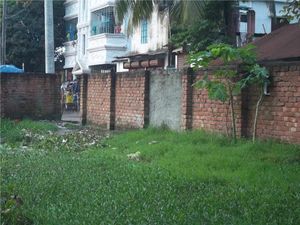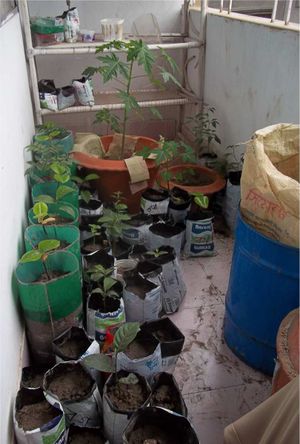m (→Tools) |
No edit summary |
||
| Line 1: | Line 1: | ||
Anyone | Anyone can become a '''guerrilla gardener'''. If you fancy quietly filling a barren urban landscape with greenery, have a go. Many people guerrilla garden in order to ... | ||
* Create an "urban foodscape" and allow for foraging. | |||
* Increase local [[food security]] (an important part of [[resilience]]) and [[self-sufficiency]]. | |||
* | * Show or investigate how easily food can grow in underused places | ||
* | * Make a political statement, similar to very informal [[community gardening]] | ||
* | * Reclaim urban land for public use and public good | ||
* | * Bringing back food-growing skills, and restoring plant life to over-developed areas. | ||
* | * Ease the decline of the [[industrial food]] system and geographically dislocated [[food supply systems]]. | ||
* | * Make the place they live more beautiful | ||
* Have fun! | |||
== Considerations == | == Considerations == | ||
Guerrilla gardening differs from ordinary gardening since exclusive access to the land is not guaranteed. The best plants are fast yielding, low maintenance, and not sensitive to other land uses. Points to note about the ''land'' are: | Guerrilla gardening differs from ordinary gardening since exclusive access to the land is not guaranteed. The best plants are fast yielding, low maintenance, and not sensitive to other land uses. Points to note about the ''land'' are: | ||
* Current condition (Soil, pollution) | * Current condition (Soil, pollution) | ||
* Prospects (Flooding? Pollution? Other land users?) | * Prospects (Flooding? Pollution? Microclimate? Other land users?) | ||
Points to note about the ''crop'' are: | Points to note about the ''crop'' are: | ||
* Growth habit (How long until fruiting/blooming? Sun or shade? Water? Temperature?) | * Growth habit (How long until fruiting/blooming? Soil type? Sun or shade? Water? Temperature?) | ||
* Environmental impact (How will it affect the soil and neighbouring plants/animals) | * Environmental impact (How will it affect the soil and neighbouring plants/animals) | ||
* Social/cultural implications (How will it change people's behaviour?) | * Social/cultural implications (How will it change people's behaviour?) | ||
== Species == | == Species == | ||
No single species of plant grows everywhere on Earth, but only in regions with the climate and other conditions it needs. Agronomists working for the USDA{{w|United States Department of Agriculture}} have defined a set of hardiness zones{{w|Hardiness zone}} which give a rough guide to the types of plants that can grow in various regions of the US. Other nations have drawn up similar schemes. The local hardiness zone not only determines what plants can grow in a given region, but also how some of them can grow. For example, some tender plants that grow as perennials{{w|Perennial plant}} in tropical climates may only grow as annuals{{w|Annual plant}} in temperate climates (e.g., tomatoes, peppers). | |||
Some regions have additional microclimate variation due to urbanization, vertical relief, or proximity to the ocean or a large lake. In such regions, a plant that grows well in one location may fare poorly in a neighboring location just a few kilometers away. | |||
Some regions have additional microclimate variation | |||
Generalized gardening information resources such as books provide lists of prospective plants to consider, but there is often no substitute for the knowledge of expert local gardeners, who learn from experience what to grow in their locality and how to grow it. If you | Generalized gardening information resources such as books provide lists of prospective plants to consider, but there is often no substitute for the knowledge of expert local gardeners, who learn from experience what to grow in their locality and how to grow it. If you can find local experts and study what they do, this will save you learning by trial and error. | ||
Guerrilla gardens may receive little care after planting. Since the gardener typically does not own the land, and may not have regular or legal access to it, plants in the garden may have to do without some or all of the typical garden services such as watering, staking, weeding, fertilizing, etc. | Guerrilla gardens may receive little care after planting. Since the gardener typically does not own the land, and may not have regular or legal access to it, plants in the garden may have to do without some or all of the typical garden services such as watering, staking, weeding, fertilizing, etc. | ||
| Line 31: | Line 31: | ||
=== Papaya === | === Papaya === | ||
[[File:2011-08-13 | [[File:2011-08-13 Guerrilla gardened papayas on wasteland.jpg|right|thumb|5 month old papayas growing on wasteland]] | ||
[[Papaya]] is an excellent species for | [[Papaya]] is an excellent species for guerrilla gardeners in tropical urban areas, since | ||
# Its shallow, soft roots, mean it can grow right beside walls and buildings without difficulty. | # Its shallow, soft roots, mean it can grow right beside walls and buildings without difficulty. | ||
# Its sap makes it unappealing to cows. | # Its sap makes it unappealing to cows. | ||
| Line 38: | Line 38: | ||
# It does not need much attention. | # It does not need much attention. | ||
[[File:2011-08-13 Pair of Guerilla gardened papayas in Dhaka, Bangladesh.jpg|right|thumb|Guerrilla gardened papayas near a wall to protect from wind]] | |||
The main points to watch are | The main points to watch are | ||
# It cannot handle standing water, so plant on higher land. | # It cannot handle standing water, so plant on higher land. | ||
# It is a demanding plant, so will not do well on poor soil. | |||
# It is usually dioecious{{w|Dioecious}} (male and female), so plant several together, and remove some of the males. | # It is usually dioecious{{w|Dioecious}} (male and female), so plant several together, and remove some of the males. | ||
# It cannot handle wind, so right beside a wall is good. | # It cannot handle wind, so right beside a wall is good. | ||
Revision as of 17:06, 30 August 2011
Anyone can become a guerrilla gardener. If you fancy quietly filling a barren urban landscape with greenery, have a go. Many people guerrilla garden in order to ...
- Create an "urban foodscape" and allow for foraging.
- Increase local food security (an important part of resilience) and self-sufficiency.
- Show or investigate how easily food can grow in underused places
- Make a political statement, similar to very informal community gardening
- Reclaim urban land for public use and public good
- Bringing back food-growing skills, and restoring plant life to over-developed areas.
- Ease the decline of the industrial food system and geographically dislocated food supply systems.
- Make the place they live more beautiful
- Have fun!
Considerations
Guerrilla gardening differs from ordinary gardening since exclusive access to the land is not guaranteed. The best plants are fast yielding, low maintenance, and not sensitive to other land uses. Points to note about the land are:
- Current condition (Soil, pollution)
- Prospects (Flooding? Pollution? Microclimate? Other land users?)
Points to note about the crop are:
- Growth habit (How long until fruiting/blooming? Soil type? Sun or shade? Water? Temperature?)
- Environmental impact (How will it affect the soil and neighbouring plants/animals)
- Social/cultural implications (How will it change people's behaviour?)
Species
No single species of plant grows everywhere on Earth, but only in regions with the climate and other conditions it needs. Agronomists working for the USDAW have defined a set of hardiness zonesW which give a rough guide to the types of plants that can grow in various regions of the US. Other nations have drawn up similar schemes. The local hardiness zone not only determines what plants can grow in a given region, but also how some of them can grow. For example, some tender plants that grow as perennialsW in tropical climates may only grow as annualsW in temperate climates (e.g., tomatoes, peppers).
Some regions have additional microclimate variation due to urbanization, vertical relief, or proximity to the ocean or a large lake. In such regions, a plant that grows well in one location may fare poorly in a neighboring location just a few kilometers away.
Generalized gardening information resources such as books provide lists of prospective plants to consider, but there is often no substitute for the knowledge of expert local gardeners, who learn from experience what to grow in their locality and how to grow it. If you can find local experts and study what they do, this will save you learning by trial and error.
Guerrilla gardens may receive little care after planting. Since the gardener typically does not own the land, and may not have regular or legal access to it, plants in the garden may have to do without some or all of the typical garden services such as watering, staking, weeding, fertilizing, etc.
Perennial plants may be especially advantageous for the guerrilla garden, as they typically require little care once established, can grow productively for years, compete better with weeds, and put down deep root systems that resist drought and draw nutrients from the subsoil to the surface.
Papaya

Papaya is an excellent species for guerrilla gardeners in tropical urban areas, since
- Its shallow, soft roots, mean it can grow right beside walls and buildings without difficulty.
- Its sap makes it unappealing to cows.
- It quickly grows an attractive fruit (often within a year).
- It does not need much attention.

The main points to watch are
- It cannot handle standing water, so plant on higher land.
- It is a demanding plant, so will not do well on poor soil.
- It is usually dioeciousW (male and female), so plant several together, and remove some of the males.
- It cannot handle wind, so right beside a wall is good.
- The more sun, the better, so a south facing, white wall, is ideal.
Tools

- Seed bombs
- Seed box. A pocket size, waterproof box is invaluable.
- Nursery. Land on the margins of roads or paths is unsuitable for direct sewing of seeds since seedlings would likely be trodden underfoot or consumed by passing livestock. The solution a safe nursery in which to growing seedlings until they are large enough to be planted out.
- Cardboard mulch. You may wish to plant an area covered in weeds. In this case, cover the weeds with a sheet of cardboard. Cut a small hole in the sheet and insert the seedling you're planting through this hole. The cardboard will kill the weeds by blocking out light. The weeds will then decompose and become nutrients for your plants. The cardboard will decompose too, though it takes a little longer.
Interwiki links
- Wikipedia: Guerrilla gardening
- wikiHow: How to Start Guerilla Gardening (Note this is an incompatible license - do not copy between the Appropedia and wikiHow pages.)